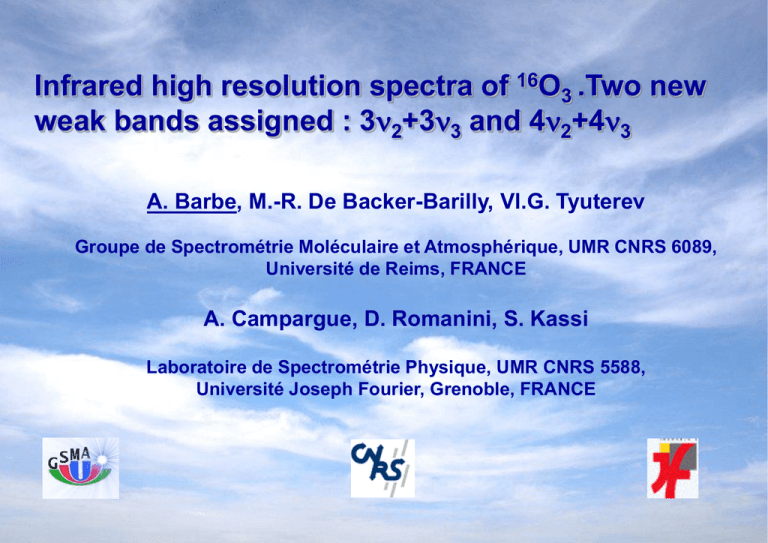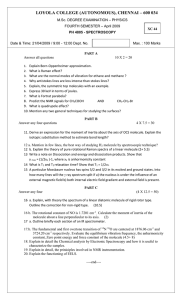Infrared high resolution spectra of O .Two new weak bands assigned : 3
advertisement

Infrared high resolution spectra of 16O3 .Two new weak bands assigned : 32+33 and 42+43 A. Barbe, M.-R. De Backer-Barilly, Vl.G. Tyuterev Groupe de Spectrométrie Moléculaire et Atmosphérique, UMR CNRS 6089, Université de Reims, FRANCE A. Campargue, D. Romanini, S. Kassi Laboratoire de Spectrométrie Physique, UMR CNRS 5588, Université Joseph Fourier, Grenoble, FRANCE Ozone generation at 77 K : complete conversion O2 → O3 Fourier Transform Spectrometer Working in stepping mode, 3 meters path difference. Recent experimental improvements: Use of two detectors The compact fibered CW-CRDS spectrometer (Grenoble) 1480-1687 nm (5800-7000 cm-1) 6nm/diode 40 diodes Typical sensitivity 310-10 cm-1 Laser diode Lambdameter =f(T,I) Optical isolator threshold Laser OFF laser ON -50 0 Photodiode 50 100 Coupler AO Modulator Hamiltonian matrix Vibrational diagonal block 1 1 1 H E A B C J B C J B C J J J J J 2 2 2 J , J 2 J J H J H J J H J J H J h J , J VV VV 2 2 2 z K 2 2 z xy h J , J KJ where 2 2 z xy 2 J J 2 6 xy K 2h J 2 J 2 xy A, B AB BA 4 xy 4 z KJ 2 2 z JK 2 K 2 z JK 2 2 z 2 2 z 2 J 3 J K 4 2 z xy J 2 2 J J J and 2 2 2 xy x y Ro-vibrational extradiagonal blocks H VV ' Coriolis J J C J J 1 / 2 J 1 / 2 J C J J 1 / 2 J 1 / 2 J C J J J C J J C J J 1 / 2 J 1 / 2 J C J J J 1 / 2 J 1 / 2 J ... C 001 011 z 021 2 z H VV ' Anharm 201 211 3 z 3 2 z 3 031 z 2 003 3 2 z z z F F J F J F J J ... 2 000 020 1 i where J J J 2 200 x z 002 2 2 y Assignments : vibration : predictions from Vl. G. Tyuterev – keep the usual label v1 v2 v3. rotation : use of ASSIGN program (Chichery A.) based on Ground State Combination Differencies (GSCD) - J Ka Kc calculation of energy levels, transitions, and intensities : GIP program. (S. A. Taskhun) Line intensities The linestrenghths are calculated using the following effective transition moment operators : ' For A-Type band : v 3 v 3 odd ( v1v 2 v 3 )( v1' v '2 v '3 ) ~ 12 , iJ i , J d 12 ,J d 7 x , J x , J z i y , iJ y , J z d 8 z , J 2xy z d1z d 2 z , J 2 d 3 z , J 2z d 4 x y y x 5 x x , Jz i y , iJ y , J z d 6 1 x , iJ y i y , J x 2 ' For B-Type band : v 3 v 3 even z d1 x d 2 x , J 2 d 3 x , J 2z d 4 i y , J z d 5 z , iJ y d 6 z , J x , J z d 7 ( v1v 2 v 3 )( v1' v '2 v '3 ) ~ d8 1 x , J 2xy i y , iJ x , J y 2 Where A, B AB BA and d i vv' d i 1 x , J 2xy i y , iJ x , J y 2 Spectroscopic parameters of the (033) state (in cm-1) Parameter (033) (132) EVV 4991.358999(78) 5042.301(13) A-(B+C)/2 3.1743889 (48) (g) (B+C)/2 0.39986321 (36) (g) (B-C)/2 0.02831028 (70) (g) DK 103 0.27889267 (83) (g) DJK 105 -0.28104(46) (g) DJ 106 0.41834 (36) (g) δJ 107 0.868(47) (g) HK x106 0.10159 (38) (g) C132,034 0.0004711 (98) 001 Statistics for the rovibrational transitions included in the fit for the (033) state Vibrational state (033) EVV 4991.3 J max 33 Ka max 13 Number of transitions 299 Number of levels 222 rms (103 cm-1) 4.77 Upper state energies derived from 033.obs v J Ka Kc 033 3 0 3 033 3 1 2 033 3 3 0 033 4 1 4 033 4 2 3 033 4 3 2 033 4 4 1 033 5 0 5 033 5 1 4 033 5 2 3 033 5 3 2 033 5 4 1 033 5 5 0 energy error(mK) tra 4996.15825 0.770 2 4999.50259 0.000 1 5024.70684 0.000 1 5002.24563 1.050 2 5012.04908 0.360 2 5027.90421 1.765 2 5050.07658 0.000 1 5003.32734 0.000 1 5006.94951 1.080 2 5016.07448 0.000 1 5031.90622 1.620 2 5054.07879 0.620 2 5082.54358 0.000 1 freq. 4937.69584 4941.48068 4942.18638 4944.44900 4945.47904 4945.47900 4945.70400 4946.50300 OBSERVED and CALCULATED ENERGIES v J Ka Kc Eobs Nb error o-c --------------------------------------------------------------033 21 9 12 5431.5388 3 1.8 -4.0 033 34 2 33 5472.7990 1 1.2 033 21 11 10 5556.4170 1 -3.0 033 20 11 10 5539.6126 2 1.6 -3.1 033 2 1 2 4996.8485 2 1.2 1.1 033 20 13 8 5688.4314 1 -4.3 033 19 0 19 5139.6244 2 1.4 -2.3 033 19 2 17 5158.8338 2 1.5 0.4 033 31 5 26 5468.2616 1 2.5 033 3 1 2 4999.5026 1 1.8 Part of the line-list for the 31+33 band Int. vup J Ka Kc vlow J Ka Kc Elow 0.133E-25 033 34 2 33 000 35 2 34 535.10314 0.103E-25 033 33 5 28 000 34 5 29 579.06128 0.165E-25 033 32 2 31 000 33 2 32 478.43898 0.184E-25 033 31 1 30 000 32 1 31 450.11768 0.146E-25 033 31 4 27 000 32 4 28 495.51739 0.161E-25 033 31 3 28 000 32 3 29 477.12347 0.127E-25 033 31 5 26 000 32 5 27 522.55763 0.201E-25 033 30 2 29 000 31 2 30 424.95173 31+33 : Obs. – Calc. 1.000 0.980 279268 3510349 P175 289278 P174 299288 3610359 P173 309298 P172 P186 0.985 319308 Transmission 0.990 P170 P171 3710369 0.995 31+33 0.975 1+43 CO2 0.970 4969.6 4969.8 4970 4970.2 CO2 4970.4 4970.6 Wavenumber (cm-1) 4970.8 4971 4971.2 4971.4 Spectroscopic parameters of the 044 vibrational state (in cm-1) Parameter (044) EVV 6506.12800(11) A-(B+C)/2 3.2109622(99) (B+C)/2 0.39209216(25) (B-C)/2 0.02782101(25) DK 103 0.32159(25) DJK 105 -0.1240(10) DJ 106 0.60039(19) δJ 106 0.13131(10) δK 105 0.69839(16) Statistics for the rovibrational transitions included in the fit for the (044) state Vibrational state (044) EVV 6506.1 J max 49 Ka max 7 Number of transitions 304 Number of levels 149 rms (103 cm-1) 3.79 Integrated band intensities, Sv, in (cm/molecule at 296K) and Parameters of the effective transition moment operator (in Debye). 42 +43 B-type (Sv =1.7310-25 cm/molecule) Operator Parameters Value Number of transitions (J max, Ka max) rms deviation (%) 44, 5 X z ,iJ y d1 (×105) -0.1240(24) d5 (×106) 0.33071(43) 84 The rms deviation applies to the quantity (Iobs-Icalc)/Iobs 31.0 42+43 : Obs. – Calc. 0.20 Absorption coefficient (10 -6 cm-1) 0.18 0.16 CO2 0.14 0.12 0.10 0.08 171180 0.06 0.04 Int.~5×10-28 cm/molecule 160171 244235 431420 0.02 0.00 6482.9 6483 6483.1 6483.2 6483.3 6483.4 Wavenumber (cm-1) 6483.5 6483.6 6483.7 Comparison between observed and predicted vibrational energies (in cm-1) (033) EVV (044) Obs (this work) pred Obs.-Calc. Obs (this work) pred Obs.-Calc. 4991.359 4991..447 -0.088 6506.128 6508.152 -2.02 Check of the vibrational assignment to the 6506.128 cm-1 observed band Observed (044) pred O-C (044) (600) pred O-C (600) Ev 6506.128 6508.152 -2.02 cm-1 6500.188 +5.9 cm-1 (B-C)/2 0.0278 0.02847 -0.239 % 0.01418 51.0 % (B+C)/2 0.39209 0.39253 -0.11 % 0.42008 -6.6% A- (B+C)/2 3.2109 3.19330 0.55 % 0.42008 2.26% A 3.603 3.5858 0.48 % 3 .5494 1.49 % B 0.41991 0.42100 -0.25 % 0.43427 -3.41% C 0.36427 0.36427 0.0 % 0.40590 -11.4 % Summary of all the known energy levels of 16O3 derived from high resolution observation and analysis 34 levels ( A1 symmetry) 0.000 700.909 1103.111 1399.284 1796.232 2057.907 2094.965 2201.133 2486.594 2726.128 2886.251 3083.698 3173.894 3289.912 3390.914 3739.327 3966.794 000 010 100 020 110 002 030 200 120 012 210 102 130 300 022 112 310 40 levels ( B1 symmetry) 4001.183 4141.196 4390.492 4632.595 4783.321 4921.987 5171.347 5540.339 5766.322 6048.496 6099.417 6155.100 6344.360 6366.074 6626.891 6749.344 6767.668 004 202 122 014 212 104 302 114 204 034 510 124 124 430 016 520 242 1042.057 1726.540 2110.829 2407.973 2785.191 3046.115 3086.197 3186.389 3455.748 3698.148 3849.786 4021.674 4121.996 4250.194 4346.439 4508.096 4658.670 4896.843 4918.791 4990.985 001 011 101 021 111 003 031 201 121 013 211 103 131 301 023 221 113 311 005 033 5077.184 5291.264 5307.739 5518.676 5697.719 5782.889 5920.061 5946.236 6063.602 6126.043 6197.822 6307.230 6355.496 6386.553 6567.851 6587.535 6721.701 6896.134 6980.691 6991.832 005 123 401 213 015 105 133 411 105 223 331 025 501 223 421 205 233 035 511 233 Conclusion As the energy increases, the number of interacting levels becomes larger and larger. Then a confident assignment accounting for interacting “Dark” states is almost impossible without good predictions of their band centers and rotational constants. The point is that these good predictions allow the assignments of weaker and weaker bands (lines of a few 10-28 cm/molecule become possible). The observation of the 42 + 43 band is a typical example. The application of this point will be also demonstrated in the next talk. O3 is then now one of the most studied molecule, where the energy levels of 74 vibrational states are obtained up to 7500 cm-1, approaching the dissociation limit. The range of derived observed intensities is large: One transition of the 3 band is: 410-20 cm/molecule ,which has to be compared with the total intensity derived in this work: Sv tot (42 + 43 ) =1.7310-25 cm/molecule Sv tot (3 ) =1.4110-17 cm/molecule, leading to a ratio of 108 between 3 and 42+43 bands



